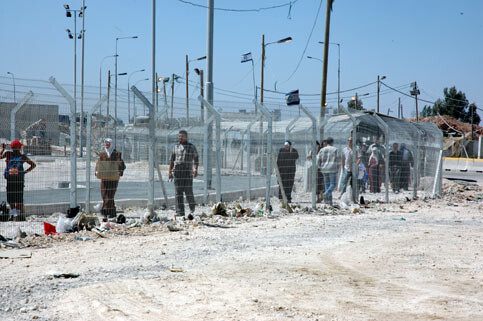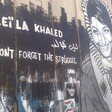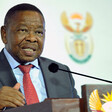The Electronic Intifada 9 April 2006

Palestinians are crossing Qalandia checkpoint through the new wired way which has been built after the closing of the wall within a night, in the West Bank town of Ramallah August 30, 2005. (MAANnews/Charlotte de Bellabre)
On March 28, Rifat Odeh Kassis wrote in his contribution Fatah Chapter Closed: Creating a Palestinian National Congress that a different political body must be build to represent the Palestinian people everywhere. “A body, which will reorganise the Paletinian struggle to achieve its aims.” In response we analyse the history of the struggle for freedom and democracy of the South African National Congress (ANC) in order to inspire Palestinians to explore new strategies. The information available on the website of the ANC has been of great value in writing this article.1
The ANC is formed in 1912
African kingdoms fought the Dutch (Boer) and British white settlers over land and cattle for over 230 years. In the 1860’s Britain brought large armies with horses and modern weapons to enforce control over South Africa. By 1900 Britain had broken the power of the African kingdoms. In 1910 Britain handed over the power to the Boer and British settlers. The union of South Africa was created that only recognised the rights of white people.
Black South Africans had to find new ways to fight for their land and their freedom. In 1911, Pixley ka Isaka Seme called on Africans to forget the differences of the past and unite together in one national organisation. He said: “We are one people. these divisions, these jealousies, are the cause of all our woes today.”
On 8 January 1912, chiefs, representatives of people’s and church organisations, and other prominent individuals gathered in Bloemfontein and formed the African National Congress. The ANC declared its aim to bring all Africans together as one people to defend their rights and freedoms.
Between 1912 and 1948 the ANC’s approach favoured dialogue. During this time the leadership of the ANC believed in the humanity of whites in South Africa. They believed in the possibility of reaching a just settlement through persuasion. These beliefs were rebutted by a racist regime that persisted with its policies of dispossession. The pursuit of a solution through dialogue was never abandoned by the ANC, but it was later supplemented by other strategies directed at putting pressure on the regime to come to the negotiating table. Dialogue thus remained the ANC’s first pillar in its liberation struggle.
New energy from the youth
With increasing attacks on the rights of black people and after the declaration of Apartheid as state policy, the ANC Youth League, under the leadership of, amongst others, Nelson Mandela, Walter Sisulu and Oliver Tambo started to agitate within the ANC for a change in strategy. They saw a need for a more militant response from the ANC. The Youth League drew up a Programme of Action2 calling for strikes, boycotts and defiance. It was adopted by the ANC in 1949, the year after the National party came to power. The Defiance Campaign was one of the first major campaigns to resist apartheid that was organised.
With the Defiance Campaign a mass movement of resistance to apartheid emerged. Apartheid aimed to separate the different race groups completely through laws including strict pass laws and forced removals. “Non-Europeans” walked through “Europeans Only” entrances and demanded service at “White’s Only” counters of post offices. Africans broke the pass laws and Indian, Coloured and White “volunteers” entered African townships without permission. The success of the Defiance Campaign encouraged further campaigns against apartheid laws.
The apartheid government tried to stop the Defiance Campaign by banning its leaders and passing new laws to prevent public disobedience. However, the campaign had already made huge gains. It brought closer co-operation between the ANC and the SA Indian Congress, increased their membership and led to the formation of new organisations. All organisations came together to organise a conference of all the people of South Africa, which presented people’s demands for the kind of South Africa they wanted. At the Congress of the People at Kliptown on the 26th June 1955 the Freedom Charter, which expressed the demands of the people, was adopted 3
Anti-pass campaigns were taken up in 1960. On the 21st March people were asked to leave their passes at home and gather at police stations to be arrested. In Sharpville the police opened fire on the unarmed and peaceful crowd, killing 69 and wounding 186. This brought an end to a decade of peaceful protest. The ANC and the PAC. Were banned and thousands activists were arrested.
In 1960 Umkhonto WeSizwe4, the armed wing of the ANC, was founded. Its main target was attacking symbols of oppression, and not people. From 1960 - nearly 50 years after the formation of the ANC - until its integration into the South African National Defence Force in 1994, armed resistance was the second pillar of the ANC’s liberation struggle.
Mass mobilisation
The two pillars of dialogue and armed resistance have contributed to the ultimate demise of apartheid, but by far the most significant pillar was that of mass mobilisation inside the country, the third pillar Early ANC campaigns such as the defiance campaign against unjust laws of the 1950s were informed by the analysis that it is the masses of the oppressed themselves who will determine the course of their liberation. The height of mass mobilisation was the formation of the Mass Democratic Movement (MDM) in the 80s. This movement was formed to fill a void that was left by the banning of political activity and political formations, including the ANC. The MDM brought together all formations that were opposed to apartheid, including trade unions, students’ organisations, women’s organisations, NGOs, civic structures, academic formations, sympathetic business structures, etc. These were all brought together under the banner of the United Democratic Front (UDF). Some of the campaigns that were organised included the million signature campaign denouncing apartheid in 1984. Two years later, the largest stay away in the history of South Africa took place. Other actions included a rent boycott in Soweto and a two day strike to protest the exclusion of Black people from parliamentary elections.
These are a few examples of how the MDM maintained an internal boycott campaign, which was the major spur to an overwhelming international response that saw the imposition of a comprehensive embargo against South Africa.
International pressure and solidarity
With calls for campaigns for international support and assistance from the rest of the world the fourth pillar in the struggle was a fact. Already in 1959, Chief Albert Luthuli, then president of the ANC, asked the British people to boycott South Africa, stating that “…non-white South Africans have responded to attacks on them by sending deputations and submitted petitions to the authorities… When these approaches were unsuccessful, they turned to passive resistance and then boycott”5. From this point onwards, the ANC sent delegations to address the international community on the need to isolate the Apartheid regime. In 1962 an appeal for action in the United States against apartheid was launched by Chief Luthuli and Martin Luther King. The call for international pressure through boycotts, sanctions and divestment became an important fourth pillar of the ANC’s struggle for democracy.
International pressure gained momentum and in 1969 revolving credit loans by US banks amounting to US$40m were terminated when institutions and individuals withdrew about US$23 million from the banks concerned. In 1973, loans of about US$70m by a consortium of US and European banks were also terminated. This trend continued and South Africa declared a debt standstill in 1985, due to capital flight.
The impact of calls for boycotts, sanctions and divestments against an oppressive regime often takes decades to show, but once results can be seen, they act as an “avalanche” whose end is the demise of the oppressive regime.
The success of calls for international isolation was partly due to the role that was played by South Africans in exile. They worked tirelessly at raising the level of awareness of the international community to the atrocities being committed by the apartheid regime.
The power lies in the vision
The Freedom Charter clearly expressed the vision for the future of the South African people. I states: We, the People of South Africa, declare for all our country and the world to know: that South Africa belongs to all who live in it, black and white, and that no government can justly claim authority unless it is based on the will of all the people; that our people have been robbed of their birthright to land, liberty and peace by a form of government founded on injustice and inequality; that our country will never be prosperous or free until all our people live in brotherhood, enjoying equal rights and opportunities; that only a democratic state, based on the will of all the people, can secure to all their birthright without distinction of colour, race, sex or belief; And therefore, we, the people of South Africa, black and white together equals, countrymen and brothers adopt this Freedom Charter; And we pledge ourselves to strive together, sparing neither strength nor courage, until the democratic changes here set out have been won.
In 1958 ANC president Chief Albert Luthuli held a speech titled “Our Vision is a Democratic Society”. He said: One might ask, “Is this vision of a democratic society in South Africa a realisable vision? Or is it merely a mirage?” I say, it is a realisable vision. For it is in the nature of man, to yearn and struggle for freedom. The germ of freedom is in every individual, in anyone who is a human being. In fact, the history of mankind is the history of man struggling and striving for freedom. Indeed, the very apex of human achievement is freedom and not slavery. Every human being struggles to reach that apex.6
He was right.
Bangani Ngeleza and Adri Nieuwhof are independent consultants and human rights advocates from respectively South Africa and the Netherlands.
Endnotes
[1] Umzabalazo: A history of the African National Congress
[2] Programme of Action: Statement of Policy Adopted at the ANC Annual Conference (17 December 1949)
[3] The Freedom Charter, Adopted at the Congress of the People, Kliptown (26 June 1955)
[4] Manifesto of Umkhonto we Sizwe, Leaflet issued by the Command of Umkhonto we Sizwe (16 December 1961)
[5] Statement by Albert Luthuli (Jointly with Dr G.M Naicker and Peter Brown) appealing to the British people to boycott South Africa.
[6] Our Vision is a Democratic Society, Speech at a public meeting organized by the South African Congress of Democrats in Johannesburg in 1958 to hear the President General of the African National Congress. Chief Lutuli was served with banning orders soon after this speech.
Related Links





